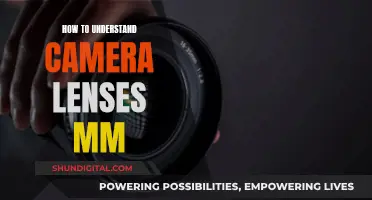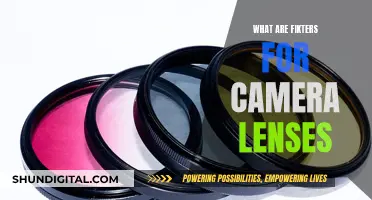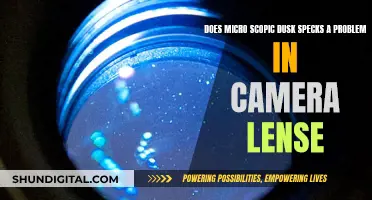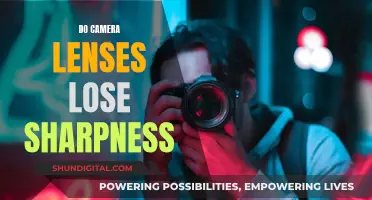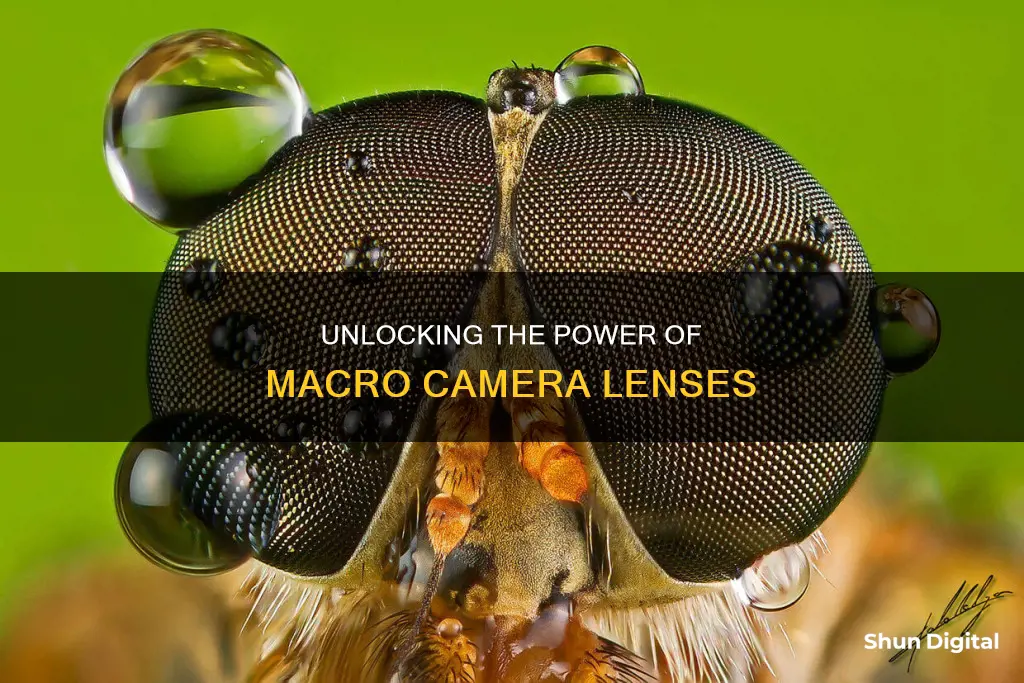
Macro lenses are a type of camera lens designed for close-up photography. They allow you to focus on a subject at an extremely close range, resulting in sharp and detailed images where the subject appears larger than life. This makes them ideal for photographing small objects, such as insects, flowers, and jewellery, as well as for capturing the tiny details in newborn photography or product photography. While they are optimised for close-up work, macro lenses are also versatile and can be used for portraits, landscapes, and other types of photography.
| Characteristics | Values |
|---|---|
| Purpose | To take sharp, detailed, close-up photos of small subjects |
| Subjects | Flowers, plants, insects, products, jewellery, water droplets, etc. |
| Magnification ratio | 1:1 (life-size), 1:2 (half-size), 1:3, 2:1, 5:1, etc. |
| Minimum focusing distance | 12 inches (30 centimetres) or less |
| Focal length | 35mm, 40mm, 45mm-65mm, 50mm, 85mm, 90mm-105mm, 100mm, 150mm-200mm, 180mm, etc. |
| Use cases | Nature, portraiture, food, product, landscape, and astrophotography |
What You'll Learn

The magnification ratio of a macro lens
Macro lenses with a shorter focal length (around 35mm to 50mm) are often limited to a ratio of 1:2, meaning the subject will appear half life-size. However, you can use extension tubes to achieve a 1:1 magnification with these lenses.
The reproduction ratio is important when determining whether a lens is considered a true macro lens. A lens must be able to achieve at least a 1:1 magnification ratio to be classified as a true macro lens.
- Suppose you are photographing a small child, 1 meter in height. If the height of the child's projection onto the sensor is 1cm, the magnification ratio is 1cm/100cm or 1:100, meaning the child is 100 times larger in real life than its image as projected on the sensor.
- If the subject is a 10cm long lizard, and its projection on the sensor is 2cm long, the magnification ratio is 2cm/10cm or 1:5. The lizard is five times larger in real life than its projection on the sensor.
- The dragonfly is about 60mm in width. If the sensor is 22mm wide, the magnification ratio is 22mm/60mm, or approximately 1:2.7.
It's worth noting that sensor size does not alter magnification. The degree of magnification depends on focal length and subject distance exclusively. With a fixed focal length, magnification is inversely related to subject distance. Getting closer to the subject will always result in a larger magnification.
When purchasing a dedicated macro lens, it is important to pay attention to the magnification ratio and minimum focusing distance. If you want true macro results, look for a lens with a magnification ratio of 1:1 or higher.
Lens Compatibility: EF-S Cameras and EF Lenses
You may want to see also

The minimum focusing distance
When choosing a macro lens, it's important to consider the trade-off between the minimum focusing distance and the working distance. A shorter minimum focusing distance allows you to get extremely close to your subject, resulting in greater magnification. However, this can be a disadvantage when photographing subjects that are easily scared or when your shadow becomes an obstruction in the frame. Longer focal length macro lenses provide a more comfortable working distance, making them ideal for capturing insects and other small creatures.
In addition to the minimum focusing distance, another critical factor to consider is the magnification ratio. A magnification ratio of 1:1, also known as "life-size," is considered the standard for true macro lenses. This means that the image formed on the sensor is the same size as the subject. Lenses with a 1:2 ratio are also considered macro lenses but produce half "life-size" images. To achieve higher magnification ratios, such as 2:1 or 5:1, you may need specialised ultra-macro lenses or the use of extension tubes.
Anti-Fog for Camera Lenses: Cat Crap's Effectiveness
You may want to see also

Macro lenses for portrait photography
Macro lenses are a great choice for portrait photography, especially for headshots and close-up portraits. They are designed to capture the tiniest of details and are known for their outstanding sharpness and ability to focus extremely close to the subject. This results in crisp, clean, and razor-sharp images with amazing detail, making them ideal for printing.
The most common macro focal length is around 100mm, which is often considered the perfect focal length for headshots. Macro lenses also come in other focal lengths, such as 50mm, 60mm, and 90mm, which can be useful for everyday photography and capturing scenes with a natural background perspective.
However, there are a few downsides to using macro lenses for portrait photography. Macro lenses tend to be darker, with a maximum aperture of f/2.8, and they lose maximum aperture as they focus closer than infinity. They are also generally slower due to their longer focus range, and their autofocus may not be as accurate as that of similarly priced non-macro primes. Additionally, macro lenses can be more expensive, as they are specialised products with lower sales volumes.
Ultimately, the choice of using a macro lens for portrait photography depends on individual preferences and the specific needs of a given shoot.
The Ultimate Camera Lenses for Professional Photography
You may want to see also

Macro lenses for landscape photography
Macro lenses are a great addition to your kit for landscape photography. While they are often associated with close-up, detailed shots, they are also a "supremely capable tool" for landscapes.
A macro lens is a lens that allows you to focus extremely close to a subject, making it appear large in the final image. They have very short minimum focus distances (MFDs) and a magnification ratio of 1:1 or 1:2, though some lenses with a 1:3 ratio or larger are also sometimes referred to as macro lenses.
Landscape photographers can benefit from the general sharpness and flat field of a macro lens. This can enhance edge-to-edge sharpness over non-macro lenses, which is great for landscape images. The flat field of a macro lens is particularly useful for landscape photographers wanting to capture precise two-dimensional reproductions.
The close-focus capabilities of a macro lens can be useful for landscape photography when the light isn't great and you need to focus on the micro details of a scene. For example, you can use a macro lens to focus on the small details of a landscape, such as clumps of moss, lichen, or patterns in leaves and flowers.
The focal length of your macro lens will determine your field of view, working distance, and background blur. For landscape photography, you might opt for a wider-angle or more telephoto macro lens. A 50mm focal length is a good option for everyday walk-around images, while 85mm or 105mm is ideal for portrait shooters.
A macro lens will give you the ability to photograph a scenic vista and then, without changing lenses, get a close-up photo of a small detail like a wildflower, insect, or animal.
In addition, a macro lens can also be used for astrophotography. Like camera lenses, astronomical telescopes also use flat fields, and a macro lens can be pointed at objects that are light years away to capture them.
While macro lenses are versatile, there are a couple of potential drawbacks for using them for general photography, including focus throw and light-gathering.
Mastering the Art of F-Stops in Camera Lenses
You may want to see also

The versatility of macro lenses
Macro lenses are not just for shooting close-ups of minuscule objects. They are also great for newborn photography, capturing tiny details like a baby's eyelashes, fingers, or toes. Macro lenses are also useful for product photography, especially for smaller products.
Your macro lens can also double as a portrait lens. It captures amazing detail and achieves correct focus even when you stand very close to the subject. Macro lenses also come in focal lengths that are ideal for portraits. They can produce smooth, blurry backgrounds and sharp, detailed images.
Landscape photographers can also benefit from the general sharpness and flat field of a macro lens. The flat field can enhance edge-to-edge sharpness, which is a crucial design feature for landscape images. Macro lenses also allow you to photograph a scenic vista and then, without changing lenses, zoom in on tiny details like a wildflower or insect.
Macro lenses are also useful for astrophotography. Like astronomical telescopes, they are designed with flat fields, which help with edge-to-edge sharpness. While it may seem unusual to use a macro lens for objects that are light years away, it can be done.
Protecting Camera Lenses: Preventing Fungus Growth
You may want to see also
Frequently asked questions
Macro lenses are used for taking close-up shots of small subjects, such as insects, flowers, and products. They can bring tiny details into sharp focus, magnifying them to life-size or even larger.
Macro lenses are designed to focus much closer to a subject than standard lenses, allowing you to fill the frame with your subject and capture intricate details. They typically have a magnification ratio of 1:1 or higher, which means the image on the sensor is the same size or larger than the subject.
Macro lenses offer superior magnification capabilities, allowing you to capture sharp and highly detailed images of small subjects. They can also be used for portrait photography, as they capture amazing detail and allow for correct focus at close distances. Additionally, they provide edge-to-edge sharpness, reducing distortion and ensuring that the entire image is in focus.


